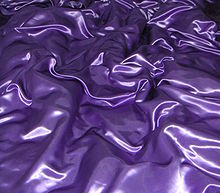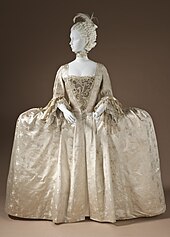Satin


A satin weave is a type of fabric weave that produces a characteristically glossy, smooth or lustrous material, typically with a glossy top surface and a dull back. It is one of three fundamental types of textile weaves alongside plain weave and twill weave.
The satin weave is characterised by four or more fill or weft yarns floating over a warp yarn, and four warp yarns floating over a single weft yarn. Floats are missed interfacings, for example where the warp yarn lies on top of the weft in a warp-faced satin. These floats explain the high luster and even sheen, as unlike in other weaves, light is not scattered as much when hitting the fibres, resulting in a stronger reflection. Satin is usually a warp-faced weaving technique in which warp yarns are "floated" over weft yarns, although there are also weft-faced satins.[1] If a fabric is formed with a satin weave using filament fibres such as silk, polyester or nylon, the corresponding fabric is termed a 'satin', although some definitions insist that a satin fabric is only made from silk.[2] If the yarns used are short-staple yarns such as cotton, the fabric formed is considered a sateen.
Many variations can be made of the basic satin weave, including a granite weave and a check weave.
Satin is commonly used in clothing, for items such as lingerie, nightgowns, blouses, and evening gowns, but is also used for boxer shorts, shirts and neckties. It is also used in the production of pointe shoes for use in ballet. Other uses include interior furnishing fabrics, upholstery, and bed sheets.
History[]

China[]
In the past, satin was made of silk, and at one time, silk could only be found and be mainly produced in China.[3] In ancient China, there were various forms of satin fabrics which came under several names, such as Duan (缎), Zhusi (紵丝), Ling (绫), Jin (锦), Wusi (五丝) and Basi (八丝).[4] Chinese satin original form was supposed to be a five-end warp satin or the six-end warp satin.[4] The six-end warp satin weave was mostly likely a derivative of the six-end warp twill weave during the Tang and Northern Song dynasty periods.[4]
Europe[]
Originally, during the Middle Ages, satin was made of silk; consequently it was expensive, used only by the upper classes. Satin became famous in Europe during the twelfth century.
Etymology[]
The word "satin" derives its origin from the Chinese port city of Quanzhou (泉州),[4] which was known as Zayton in Europe and Arab countries during the Yuan dynasty.[5] During that period, Zayton was visited by Arab merchants and by Europeans.[5][6] The Arab called silk satin imported from Zayton as "zaituni".[5] During the latter part of the Middle Ages, it was a major shipping port of silk, using the Maritime Silk Road to reach Europe. It was mostly used in the Arab world.
Types of satin weaves[]
Fabrics created from satin weaves are more flexible, with better draping characteristics than plain weaves, allowing them to be formed around compound curves, which is useful in carbon-fiber composites manufacturing. In a satin weave, the fill yarn passes over multiple warp yarns before interlacing under one warp yarn. Common satin weaves are:[7]
- 4-harness satin weave (4HS), also called , in which the fill yarn passes over three warp yarns and under one warp yarn. It is more pliable than a plain weave.
- 5-harness satin weave (5HS); the fill yarn passes over four warp yarns and then under one warp yarn.
- 8-harness satin weave (8HS), in which the fill yarn passes over seven warp yarns and then under one warp yarn, is the most pliable satin weave and forms most easily around compound curves.
Types of satin[]
- Antique satin – is a type of satin-back shantung, woven with slubbed or unevenly spun weft yarns.[8][9]
- Baronet or baronette – has a cotton back and a rayon or silk front, similar to georgette.[10]
- Charmeuse – is a lightweight, draping satin-weave fabric with a dull reverse.[11]
- Double face(d) – satin is woven with a glossy surface on both sides. It is possible for both sides to have a different pattern, albeit using the same colors.[12]
- Duchess(e) satin – is a particularly luxurious, heavy, stiff satin.[12]
- Faconne – is jacquard woven satin.[13]
- Farmer's satin or Venetian cloth – is made from mercerised cotton.[13]
- Gattar – is satin made with a silk warp and a cotton weft.[14]
- Messaline – is lightweight and loosely woven.[15]
- Polysatin or poly-satin – is an abbreviated term for polyester satin.
- Slipper satin – is stiff and medium- to heavy-weight fabric.[16]
- Sultan – is a worsted fabric with a satin face.[13]
- Surf satin – was a 1910s American trademark for a taffeta fabric used for swimsuits.[17]
References[]
- ^ Emery, Irene (1994). The Primary Structures of Fabrics. Washington, D. C. Thames and Hudson. p. 137. ISBN 978-0-500-28802-3.
- ^ Chambers Twentieth Century Dictionary, 1977.
- ^ Oxford dictionary of word origins. Julia Cresswell, Oxford University Press (Second ed.). New York. 2010. p. 381. ISBN 978-0-19-954793-7. OCLC 663824301.CS1 maint: others (link)
- ^ Jump up to: a b c d Bao, Mingxin (1986). "Early history of Satin". en.cnki.com.cn. Retrieved 2021-04-21.
- ^ Jump up to: a b c Tellier, Luc-Normand (2009) (2009). Urban world history: an economic and geographical perspective. Presses de l'Université du Québec. p. 221. ISBN 978-2-7605-1588-8. Retrieved 2010-11-28.
- ^ James E Glevin. The Modern Middle East: A History. Oxford University Press. p. 21.
- ^ "Woven fabric style guide". ACP Composites.
- ^ Young, Deborah (2015). Swatch Reference Guide to Fashion Fabrics. Bloomsbury Publishing. p. 117. ISBN 978-1628926569. Retrieved August 25, 2015.
- ^ Rowe, T. (2009). Interior Textiles: Design and Developments. Elsevier. p. 69. ISBN 978-1845696870. Retrieved August 25, 2015.
- ^ Cumming, Valerie; Cunnington, C.W.; Cunnington, P.E. (2010). The dictionary of fashion history. Oxford: Berg. p. 231. ISBN 978-1847887382.
- ^ Shaeffer 2003, p. 123.
- ^ Jump up to: a b Shaeffer 2003, p. 124.
- ^ Jump up to: a b c Lewandowski, Elizabeth J. (2011). The complete costume dictionary. Lanham, Md.: Scarecrow Press, Inc. p. 309. ISBN 9780810877856.
- ^ Maitra, K.K. (2007). Encyclopaedic dictionary of clothing and textiles. New Delhi: Mittal Publications. p. 185. ISBN 9788183242059.
- ^ Shaeffer 2003, p. 128.
- ^ Shaeffer 2008, p. 238.
- ^ Shaeffer 2003, p. 282.
Bibliography[]
- Shaeffer, Claire (2003). Sew Any Fabric. Iola, WI: Krause Publications. ISBN 9781440222627.
- Shaeffer, Claire (2008). Claire Shaeffer's Fabric Sewing Guide. Cincinnati, Ohio: Krause Publications. ISBN 978-1440223426.
External links[]
- Woven fabrics
- Weaves



